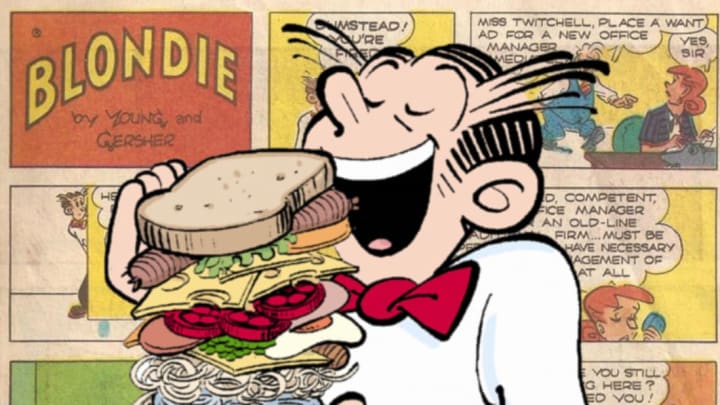Reading the comics page each day, that little grid of squares can look like an unchanging edifice. Charles Schulz has been dead for more than a decade, but Snoopy still flies his Sopwith Camel. Dagwood still inhales gigantic sandwiches, and the Family Circus still is read only by your grandparents.
But back in the day, comic strips changed often. Characters came and went. Plot lines and themes fluctuated as the nation grappled with the Great Depression and World War II. And some strips—not all, but more than you might expect—changed their course completely. Here are four that you might not have recognized in their original form.
1. Blondie
Cartoonist Chic Young had created a string of strips about airheaded young women (The Affairs of Jane, Beautiful Bab, and Dumb Dora) before landing on, simply, Blondie. The strip, which debuted in 1930, depicted the adventures of a vivacious flapper named Blondie Boopadoop.
One of her boyfriends was, you guessed it, Dagwood Bumstead. What you might not expect was that Dagwood was the son of railroad tycoon and billionaire J. Bolling Bumstead. Blondie and Dagwood just dated casually until something went terribly wrong—newspapers began canceling the strip. Aspirational visions of huge wealth didn’t go over so well during the Depression.
So Young had Blondie and Dagwood fall desperately in love and, in 1933, marry. J. Bolling Bumstead conveniently disinherited his son for marrying below his station. That meant that Blondie and Dagwood were free to move into the suburbs and enjoy a more relatable middle-class existence.
2. Mary Worth

Wikimedia Commons
Before the modern-day Mary Worth, a gray-haired meddler lovingly mocked online, there was Apple Mary. The Depression-era comic was begun by Martha Orr in 1934 and starred a little old lady who sold apples on the street. Frank Capra had directed a movie the year before, Lady for a Day, that featured just such an old lady, so the type was fresh in the public’s imagination.
Orr left the strip in 1939 to raise her family, passing on writing chores to Ohio columnist Allen Saunders (who also wrote a strip called—really—Big Chief Wahoo). He immediately saw the possibilities in taking a new approach to the strip. “Laboring over the continuity, I chanced upon a happy idea one day,” he wrote many years later. “Instead of treacly melodrama, why not do stories of the sort that were used in popular magazines for women? No current story strip dealt with romance and psychological drama instead of action.”
The new approach caught the syndicate’s attention, and the strip’s title was soon changed to Mary Worth’s Family and, eventually, Mary Worth. The titular character left the apple cart behind, had an artistic makeover that shed some pounds, and never looked back.
3. Beetle Bailey
Courtesy of ComicVine
For a strip that’s practically synonymous with the word “Army,” it’s amazing to learn that Beetle Bailey didn’t start his run in the comic pages serving Uncle Sam. Instead, for the first six months of the comic strip, Beetle was a college student (the comic debuted in 1950, the same year as Peanuts).
But like Blondie in her early days, Beetle had problems of a business-related nature. Only 25 papers had bought the strip after those first six months, and King Features Syndicate was not pleased. So cartoonist Mort Walker (still kicking today at age 89) signed him up for the Army and shipped him off to Korea. Some 100 papers promptly added the comic.
After the war, Walker further revised the strip into the one we know and (sometimes) love today. In 1954, the Tokyo edition of the military Stars & Stripes paper dropped “Beetle,” citing negative effects on troop morale. The press back home lampooned the move, and another 100 papers bought the strip.
4. Snuffy Smith
Courtesy of Blogspot
Although not the most popular strip today, the hillbilly-themed Snuffy Smith has endured for 94 years. But it didn’t feature rural stereotypes at first, and it wasn’t even about Snuffy Smith. The ancestor of the present-day strip started in the Chicago Herald and Examiner, under the title Take Barney Google, F'rinstance. Drawn by Billy DeBeck, the strip starred Barney Google, a sports fan and gambler. The strip became hugely popular. (Barney Google’s horse, named Spark Plug, provided the nickname for a young Charles M. Schulz.)
In 1934, Barney Google met hillbilly Snuffy Smith in the redneck village of Hootin' Holler. The new character gained popularity, and by the time the decade ended, the strip had been rechristened Barney Google and Snuffy Smith. By 1954, Google left Hootin’ Holler, but the strip kept its focus on the town and its colorful residents.
The strip hasn’t totally forgotten its original namesake, though. Barney Google returns annually for a few strips, long enough for readers to wonder: “Who on earth is that?”
